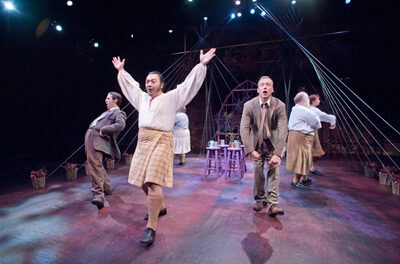The New Year’s Eve extravaganza, hosted by the North Carolina Symphony at the Meymandi Concert Hall of the Progress Energy Center for the Performing Arts, was this new Tarheel’s first visit to a very attractive concert space, and indeed, my first official “New Year’s” concert of the sort that mixes fish and fowl in appealing to a broad public. The program opened with the familiar “Emperor Waltzes” by Johann Strauss, but the evening only took flight with the arrival of purple-gowned Irish mezzo Paula Murrihy, a singer still in her twenties who is already thoroughly professional and who knows how to captivate her listeners. She has a charming smile and flashing eyes to accompany effortlessly-produced and rich tones, featured in three brief Songs of the Auvergne, arranged by Joseph Canteloube, in which she was effectively partnered by the oboe. These were over too soon. Next up was the “Danse Macabre” of Saint-Saëns, which seemed under-inflected, particularly in the lead-up to the final devilish accelerando, which lacked a compelling rhythmic drive.
The truly popular moment (and for this curmudgeon, the nadir of the program) was the arrival onstage of the Red Clay Ramblers, who were seriously over-amplified. This popular ensemble may have its charms, but the attempt to combine them with the orchestra was misguided, as the arrangements contributed nothing, and the amplification meant that the notes that the orchestra was playing were inaudible. A lame attempt at humor was the Spike Jones parody of Pagliacci, something which only really scores when those parodying have an affection and familiarity with what they are poking fun at (think Anna Russell and Gilbert and Sullivan).
After intermission came Chabrier’s “Espana,” which seemed a little too quick to be truly sensual in the Iberian manner – the rhythms needed more swing, and the whole effect was too square to be sexy.
Murrihy (now in white chemise and black skirt) came to the rescue with four of Manuel de Falla’s Popular Spanish Songs. Now her voice had an appropriately Spanish “crying” sound to its tone, and she spoke and interpreted the songs masterfully. A simply magical moment was the beautiful “Nana,” in the Moorish style, supported by suspended winds.
Music Director Grant Llewellyn waxed poetic about the charms of Hoddinot’s Welsh Dances, but to these ears there was nothing special about these works, very conservative in style (reminiscent of the sort thing you often hear for band), and with none of the winsome charm of the folk-style of Vaughan Williams, for instance.
Murrihy returned once more, and this time for something truly Irish, a late-nineteenth century parlor ballad with lyrics by poet Thomas Moore and music by Frank Lambert. Murrihy sang with a microphone, something she had already shown us she had no need of earlier. No matter — she has star quality, microphone or no.
For me the concert might have ended here, but duty obliges me to report that Red Clay Ramblers returned. Enough said?











